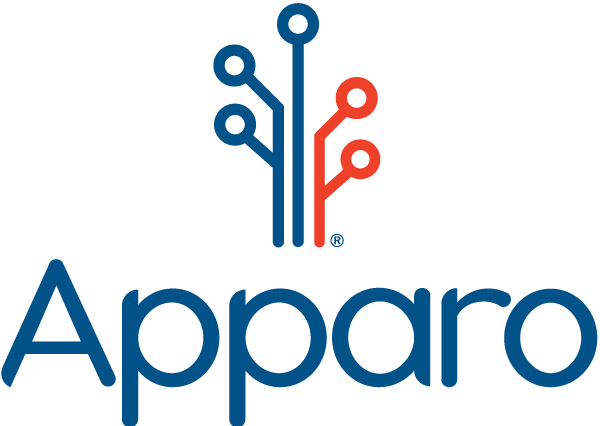4 keys and 17 tips to facilitate better hybrid meetings from Apparo Expert Link Partner, UFacilitate
By Andres Marquez-Lara (Beth Kanter, one of UFacilitate’s top experts on hybrid meetings, was of enormous help for this blog post)
In an ideal world, your meeting participants are either all in person or all online. But with the rise of global teams and remote work post pandemic, hybrid meetings are happening more and more frequently.
It is safe to say that in the past few years we’ve all been in a meeting in which some participants are physically present, while others are participating virtually. It’s also pretty safe to say most of us have experienced some degree of discomfort or awkwardness in this situation. It can be due to tech challenges that tend to come up in this complex scenario, or because managing a room full of in-person participants while ensuring the remote participants feel equally engaged can seem like an act of magic.
Well, the magic lies in effective, human-centered facilitation. A hybrid meeting can be just as productive and transformative as any, and for nonprofit organizations that rely on collaboration and engagement, ensuring everyone feels included is critical. In this blog post, we’ll explore some practical tips and strategies to help you facilitate powerful and inclusive hybrid meetings for your nonprofit.
Embrace Equity and Inclusion
- Level the playing field for the virtual participants: Position the camera at eye level, use a high-quality microphone, and avoid having in-person attendees huddle around the screen, blocking remote participants’ view. Make sure that virtual participants can hear everything that is said by positioning the microphone in the center of the table
- In room buddy: Assign a person in the room to represent a person or small group of the people online. That way this person can act as the advocate to ensure that the virtual participants are included. This is especially helpful if you decide to have hybrid breakout groups. Here’s a handy template to help you facilitate this task.
- Go to the virtual participants first: Because we are so organized by our physical bodies to thousands of years of evolution, we are likely to give priority to those present. To avoid this bias, create a group norm to always go to the virtual participants first when you open the conversation for questions or discussion.
Remember the Human Touch
- Acknowledge everyone: Address participants by name, both in-person and remote, to create a sense of connection.
- Be mindful of nonverbal cues: Pay attention to body language and facial expressions from both sides of the screen to gauge engagement and adapt your facilitation style accordingly. If people choose not to have their cameras on, that’s okay. Just check-in with them from time to time asking for emojis, chat responses or reactions on the platform you’re using.
- End on a positive note: Briefly summarize key takeaways and acknowledge everyone’s contribution.
Pre-Meeting Preparation is Key
- Clearly define the purpose: Is this a brainstorming session, a presentation, or a decision-making meeting? Knowing the goal will guide your approach and technology/methodology choices and whether or not it would work better as an all-virtual or all-in-person meeting
- Craft a concise agenda: Share it well in advance with clear objectives and specific timings for each agenda item. Think about the mode of engagement for each part of the agenda, for both the in person and virtual participants. Consider using collaborative tools like online whiteboards or shared documents to foster pre-meeting engagement.
- Consider bringing in more facilitators: Managing a hybrid meeting can be challenging. You should ideally have at least two facilitators, one who manages the in-person participants and one for virtual participants.
- Test your technology BEFORE the meeting: Try to ensure the meeting platform functions smoothly, cameras and microphones work, and any presentation materials are easily accessible to all participants. We recognize that this may not always be in your control with different internet bandwidth connections, but test it out anyway to anticipate how you will need to adapt.
- Test your tools BEFORE the meeting: Try to ensure that participants are familiar with the tools you will use, or that they’re user-friendly enough to not require prior experience. If they are new tools, you can use the time while people gather to have an easy prompt that requires people to use the tool. At the end of this blog post, you will find a list of tools we recommend.
- Check your checklist: Once you cover the above points, fill out this checklist.
Keep it Engaging:
- Vary your activities: Don’t rely on long lectures or presentations. Incorporate polls, breakout rooms, or collaborative tasks to keep everyone engaged.
- Lean into technology: Tools like Mentimeter or Slido allow everyone both in person and online to engage simultaneously.
- Visualize your ideas: Use online whiteboards, shared documents, or even physical flip charts (visible on camera) to capture ideas visually and foster collaboration.
- Be thoughtful about breakout activities: The key to successful meetings is small groups. This is still true for hybrid meetings. Depending on the context and goal of the agenda it may make sense to have the breakouts be organized by virtual vs. in person vs. hybrid. Consider this question when deciding the breakout activities: What am I trying to achieve with this breakout? If it’s a more in-depth discussion where you want diverse perspectives then make the effort to make it hybrid. If it’s a brief logistical check or a check-in it’s okay to organize the groups based on where they are physically.
- Consider more frequent meetings instead of longer meetings: Hybrid meetings require a lot of attention, so it’s better for them to be as short as possible.
By following these tips and embracing a flexible, adaptable approach, you can transform your hybrid meetings from mere logistical hurdles into opportunities for productive and inclusive collaboration.
Some tools we recommend for your virtual and hybrid meetings
Polling
Meeting Notetaker
Once you get everyone’s permission to record the meeting, use the built-in notetaker in your preferred platform. Otherwise, consider add-on apps such as:
Other useful tools
If you want to learn more or want additional support, reach out to Apparo at [email protected] to learn about working with UFacilitate through our Expert Link network.


